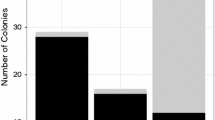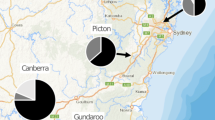Summary
The origin of sociality is best studied in taxa with rudimentary social development, like the stenogastrine wasp, Eustenogaster fraterna. Our study of colony structure and relatedness in this species found very small colonies aver-aging only 2.7 adult females, including a single mated, re-productive female. Microsatellite genotyping showed that adult females were related to each other but not generally as full sisters (r = 0.427 ± 0.131, 95% confidence interval). Microsatellite genotyping showed that sociality is not favored by the haplodiploid hypothesis, because relatedness of unmated females to female brood is low (r = 0.210 ± 0.171, 95% confidence interval), far lower than that among sisters in either haplodiploid or diploid species. Relatedness of unmated females to female brood is significantly lower than that of mated females to female brood (r = 0.374 ± 0.266). Mated females are also significantly more related to the male brood (r = 0.871 ± 0.168) than are unmated females (r = 0.588 ± 0.339), suggesting that unmated helpers do not generally produce sons. These results argue against an important role for exceptionally high relatedness in the origin of eusociality. One quarter of the brood could not have been the progeny of any collected female, suggesting high rates of queen turnover. In all, 7/17 nests had some brood that could not be assigned to existing adult females. These high adult mortality rates result in direct advantages to helpers in the form of colony inheritance, and indirect advantages via life insurance benefits.
Similar content being viewed by others
Author information
Authors and Affiliations
Corresponding author
Additional information
Received 23 October 2002; revised 13 March 2003; accepted 23 April 2003.
Rights and permissions
About this article
Cite this article
Landi, M., Queller, D., Turillazzi, S. et al. Low relatedness and frequent queen turnover in the stenogastrine wasp Eustenogaster fraterna favor the life insurance over the haplodiploid hypothesis for the origin of eusociality. Insect. soc. 50, 262–267 (2003). https://doi.org/10.1007/s00040-003-0676-2
Published:
Issue Date:
DOI: https://doi.org/10.1007/s00040-003-0676-2




